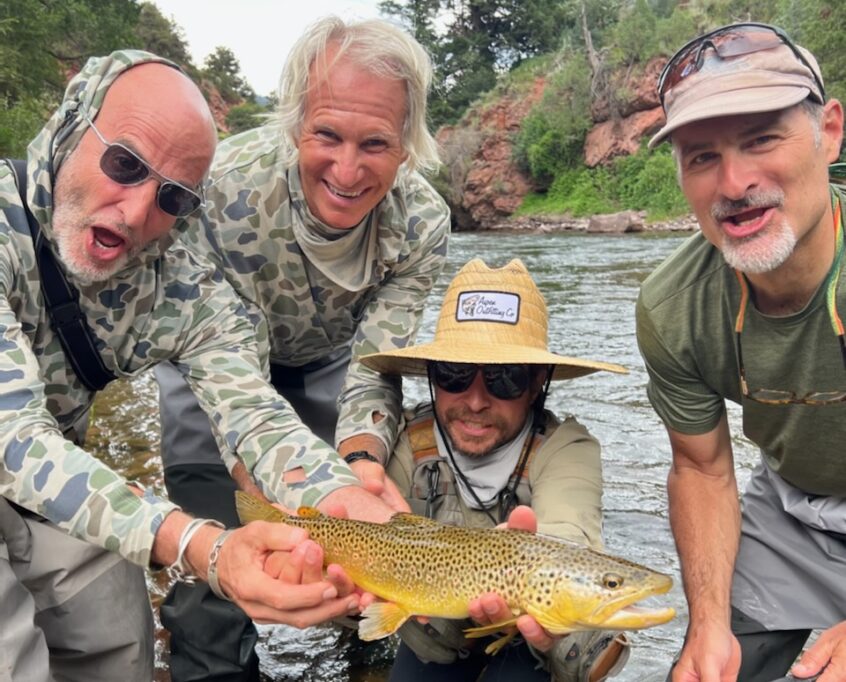Flows and Water Clarity
Flows are at 751 cfs below Maroon Creek and 1370 cfs at Emma. Water clarity is good.
Overview
Summer fishing is here! After a significant drop in flows last week the water is still coming down, but at a slower pace. Water clarity is has gotten significantly better, so downsize tippet and fish more natural imitations than you were during high water. Water temperatures at maroon creek have been fluctuating from the mid 40’s early in the morning up to the mid 50’s in the afternoon (water temps are slightly higher at emma). This temperature range means that caddis hatches are starting to happen mid morning and again later in the evening. PMD’s have started hatching in good numbers lower down on the Roaring Fork, and we expect them to make their way up the valley soon with more warm weather in the forecast. Though they aren’t hatching much up valley yet, there are lots of green drake nymphs crawling around too. Lastly, we’ve been seeing the occasional Golden Stonefly flying around! This wide variety of insect life has made the fishing great, and also gives us the opportunity to catch fish on nymphs and dry flies! If you’re not fishing, you should be!
Caddis nymphs are a staple right now. Guides Choice Hare’s Ears, Dirty Birds, Plan B caddis, Boy Buzzers and Harpers have all been producing throughout the day. Try fishing a jig style caddis (Boy Buzzer, Frenchie, Hot Mess Jig etc.) as your lead fly to imitate the abundant caddis larvae. We’re also finding success trailing caddis emerger style flies, particularly during a strong hatch. Soft hackles and caddis pupae have been effective, particularly in the flats that are starting to form as the river drops.
Golden Stonefly and Green Drake nymphs are also a great point fly to lead with right now, particularly when fishing faster water. Pat’s Rubber Legs, 20-inchers and large pheasant tails can be really effective, so don’t count out throwing some bigger flies.
Finally, get yourself some dry fly action! We’ve seen a few fish starting to rise during the mid morning, but the bulk of surface activity is happening in the evening. If you want to fish dries in the morning and mid day, try out some bigger dries and see if you can get some opportunistic fish to come up. Cover water with Stimulators, Golden Stones and Hoppers to see if you can drum up some interest (plus, you can always drop a nymph off the back). When dry fly fishing the evening, switch over to Caddis Patterns in the 14-16 range or a PMD dry, depending on where you are on the river. Green Drakes are also starting to hatch down valley, so be on the lookout for those– if you know, you know!
If you want more in depth information on the best ways to fish this week, give us a call or drop by the shop to get the most recent conditions and information.
Common Hatches and Food Sources
Caddis, Stoneflies, PMD’s and Green Drakes
Nymphs and Dries that imitate Caddis, Stoneflies, Pale Morning Duns and Green Drakes are great patterns to fish this time of year.
Hot flies & Techniques
Nymphs
Point Flies
Hot Flies: Guide’s Choice Hare’s ear (size 14-18), Dirty Bird Caddis (size 14-16), Hot Mess Jig (size 16), 20 incher (size 8-14, natural), Pat’s Rubber Legs/Girdle Bug (size black, coffee, brown 6-14), Prince Nymph (size 8-16), PMD Perdigon (14-16)
Trailing flies
Harper Soft Hackle (size 16), Soft Hackle Pheasant Tail (Size 14-18), Pheasant tail (black, natural size 14-18), Mayhem Midge (black, gray, size 18-20, pmd size 16-18).
Dries:
Hot Flies: Missing Link Caddis (14-16), Elk Hair Caddis (Tan, Olive 14-16) Royal Stimulator (classic or rubberlegs, (10-14), PMD Split Wing (14-16), H&L Variant (12-16).
Streamers:
Bring a streamer rod with you this time of year! It never hurts to target some structure and see what happens! It’s been a little streaky, but we love fishing streamers whenever we can!
Hot Flies: Sex Dungeons (White, Grizzly, Yellow, Black, Size 2) Mini Dungeons (white, natural, size 8), Thin Mint (size 8-10), Trick Or Treat (size 6).
Techniques
Nymphing is still a productive technique during this time of year, but now is also the time to fish dry fly and dry dropper set ups.
When nymphing, look for transitions in flow and depth– that’s where the trout are most likely to be! Make sure that you adjust the weight and depth of your rig to match the water you are fishing. Sometimes reaching a different part of the water column is all it takes.
Dry flies are starting to come into play now too. If you see fish rising, focus on getting a good drift and experiment with different patterns and colors until you get fish to eat. If you’re not seeing fish rise but bugs are hatching, cover a lot of water with a pattern that matches the hatch until you find some willing fish. Finally, using large dries like stimulators, hoppers and beetles in a dry-dropper rig is a fun way to mix it up and see what fish are responding to best.
Streamers are a fun tool to have in your toolbox during the summer! Small streamers with a slower retrieve tend to be best when the water is clear. Streamer fishing often takes the back seat when dry fly fishing comes into play, but it’s still a ton of fun. Focus your efforts on pools and structure and cover a lot of water for the best results.
Information About The Roaring Fork
The Roaring Fork River is a freestone river that runs 70 miles from Independence Pass through Aspen, Basalt, and Carbondale until it reaches its confluence with the Colorado River in Glenwood Springs. The cold, clean waters of this famous river support an incredible array of aquatic life including brown, rainbow and cutthroat trout. The Roaring Fork is designated as a “Gold Medal” fishery, meaning it offers some of the best trout fishing in the nation to beginners and seasoned anglers alike.

